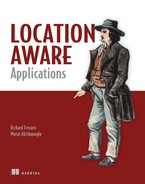Table of Contents
Chapter 1. Location-based services: an overview
1.1. What are location-based services?
1.2. Today’s commercial and consumer LBSs
1.2.1. GPS in the transportation industry
1.2.3. Emergency response services
1.3. Challenges of developing mobile LBSs
1.4. Future opportunities of LBS
Chapter 2. Positioning technologies
2.1. What are positioning technologies?
2.1.1. Cell tower triangulation
2.3. Wireless positioning systems
3.2. Comparison of mapping APIs
4.2. Content distribution formats
4.3. Licensing content from third parties
4.6. Our coding mashup example
Chapter 5. Consumer applications
5.1. Navigating to a destination
5.1.1. GPS assisted navigation on smartphones—Telmap
5.1.2. GPS assisted navigation on Nokia handsets—Ovi Maps
5.2. Connecting with other people or local places
5.2.1. Creating a story through geotagged photos—Whrrl
5.2.2. Taking location mainstream—Loopt
5.3.1. Creating adventures through location-aware apps—GPS Mission
5.4. New app development frontiers
6.2. How programming and distribution options are evolving
6.13. Mobile development frameworks
Chapter 7. Connectivity issues
7.1. Key success factors in connectivity
7.2. Security of location data
7.3. Location-aware platform examples
Chapter 8. Server-side integration
3. Creating winning LBS businesses
Chapter 9. Monetization of location-based services
9.1. The consumer as a source of revenue
9.2. Businesses as a source of revenue
Chapter 10. The privacy debate
10.1. What do we mean by privacy?
10.3. Who manages the privacy of LBS?
10.4.1. Avoiding the data privacy booby traps
10.4.2. Best practice guidelines: Cellular Telephones Industries Association
10.5. Complying with privacy legislation
Chapter 11. Distributing your application
11.1. A product is only as good as its distribution
11.3. App store discoverability
11.4. Distributing through third parties
Chapter 12. Securing your business idea
12.1.1. Choosing the right business strategy
12.1.2. Formulating your business strategy—the business plan
12.2. Funding your business strategy
12.2.1. Matching funding to stages of business growth
12.2.3. Friends, family, and fools funding
12.3. Securing your business strategy
Appendix A. Java code examples referred to in chapter 2
